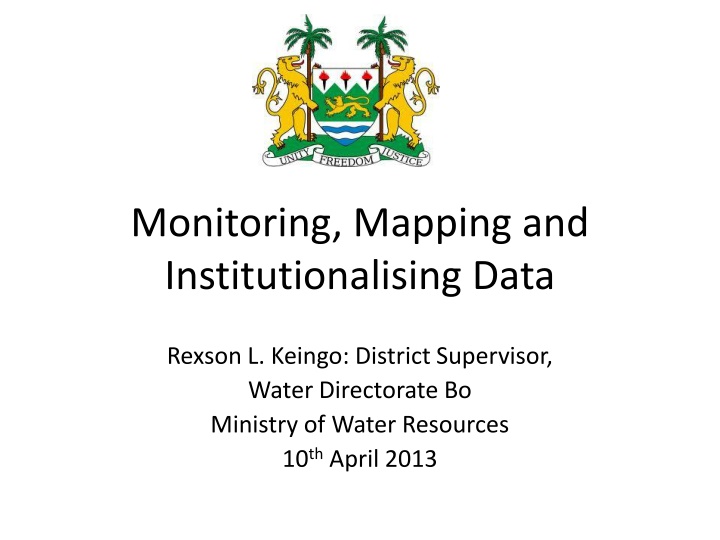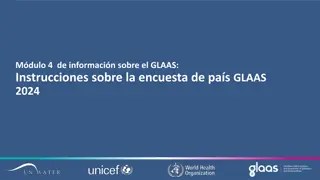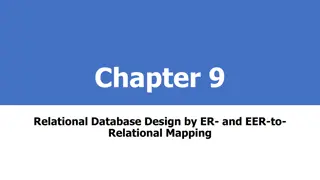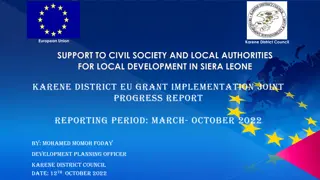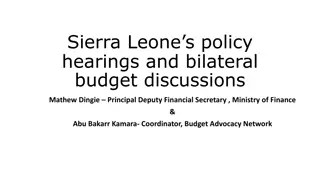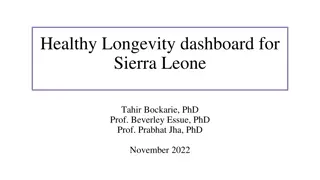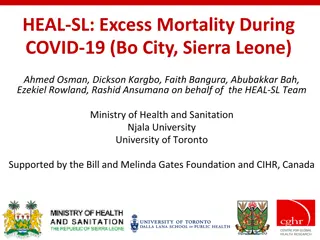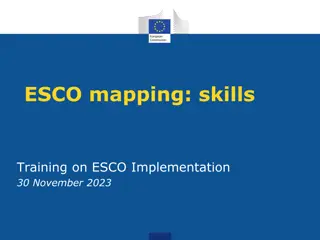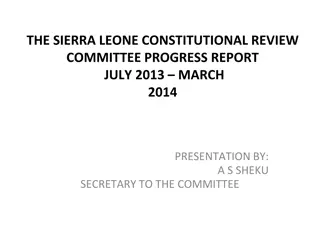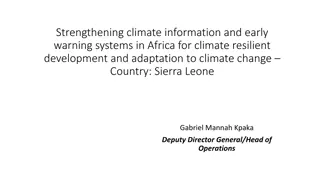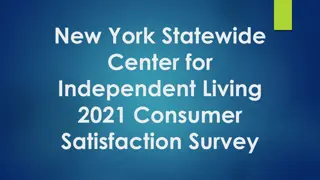Water Point Mapping Survey in Sierra Leone
The Water Point Mapping survey in Sierra Leone reveals that while there has been progress in mapping and improving water points, there are still challenges in ensuring sustainability and functionality. Issues such as seasonal water points, inadequate attention to service payments, and the need for extended community support are identified. Data shows a significant number of non-functioning water points, underscoring the importance of addressing gaps in coverage and maintenance to enhance service delivery in the region.
Uploaded on Aug 21, 2024 | 0 Views
Download Presentation

Please find below an Image/Link to download the presentation.
The content on the website is provided AS IS for your information and personal use only. It may not be sold, licensed, or shared on other websites without obtaining consent from the author.If you encounter any issues during the download, it is possible that the publisher has removed the file from their server.
You are allowed to download the files provided on this website for personal or commercial use, subject to the condition that they are used lawfully. All files are the property of their respective owners.
The content on the website is provided AS IS for your information and personal use only. It may not be sold, licensed, or shared on other websites without obtaining consent from the author.
E N D
Presentation Transcript
Monitoring, Mapping and Institutionalising Data Rexson L. Keingo: District Supervisor, Water Directorate Bo Ministry of Water Resources 10thApril 2013
Summary The Water Point Mapping survey provides Sierra Leone with a baseline of the status of Water Points (WP s) Functional sustainability in service delivery remains a major challenge The Government of Sierra Leone (GoSL) must address gaps in coverage and functionality GoSL and WASH organisations must contribute to keeping mapping data updated
Outcomes of the WPM baseline survey 28,845 improved WP s mapped 18,908 improved WP s are used. [65%] However 40% are seasonal WP s Therefore 11, 212 WP s are classed as improved, in use and functioning all year round [39%]
Observations on the current situation Mapping data show one third of water points non functioning many are seasonal Functioning water point Under construction Impaired 1,479 Partly due to inadequate attention to payment for services to meet O&M as well as some capital maintenance. 9,290 18,086 Evidence suggests that capital cost of the facility represents only 20-25% of the lifetime costs of having and sustaining service delivery 4
Number of all public improved points and protected, in use points by district All public points (incl. broken & under construction) 4,902 2,429 1,022 2,299 992 3,659 1,782 1,994 1,685 2,013 767 1,742 1,865 Population per protected in-use point (non-seasonal in brackets) 157 (235) 302 (617) 239 (440) 261 (527) 480 (1426) 203 (289) 251 (496) 311 (549) 291 (583) 363 (935) 530 (755) 535 (1012) 147 (187) Protected, in- use points % of all District Population [i] Bo Bombali Bonthe Kailahun Kambia Kenema Koinadugu Kono Moyamba Port Loko Pujehun Tonkolili W.A. Rural W.A. Urban (Freetown) 544,745 485,888 165,604 422,781 320,842 592,903 312,682 399,113 304,262 536,862 265,608 410,869 209,275 3,437 1,584 693 1,546 596 2,754 1,141 1,269 990 1,340 491 745 1,338 70% 65% 68% 67% 60% 75% 64% 64% 59% 67% 64% 43% 72% 976,984 1,694 984 58% 866 (1237) Total 5,948,418 28,845 18,908 66% 300
Observations on the WPM survey The impacts of our interventions do not last Services provided are not cost effective The need for continued extended support to communities is visible The need to address basics and construct wells at the "right time of year The need to safeguard against environmental degradation monitoring groundwater resources The importance of monitoring and ensuring functionality
Seasonal variation in access Wet season Dry season
Benefits of WPM Provides visually mapped data for monitoring the status of water points Highlights issues of equity, inclusiveness and targeting Underpins Sector Performance Monitoring (SPM) Will influence national and local level planning WPM database can be integrated with hydrogeological database and other studies
Water Point Mapping..next steps Sierra Leone now has a baseline for water point coverage the easy part Updating maps and addressing non functionality is the major challenge Need for a WASH sector strategy to deliver sustainable services at national, regional and local levels Need to improve sector monitoring and mapping so that WPM informs National Sector Learning Review
Five important considerations for WPM 1. WPM evidence should form the basis for national and local level planning 2. Ensure technology choices (i.e. type of hand pumps, spare parts) aligned to field capacities 3. WPM data needs to be collected, assimilated, verified, analysed and presented 4. Updating process needs to be sustainable 5. Requires dedicated staff to report on the status of water points
Sustainability (1) Issues to address Technological challenges and the use of GIS Procedures for collecting, reporting and updating WPM data Accountability challenges collective action, inter- sectorial coordination to keep WPM data updated and service delivery
Sustainability (2) Recommendations Ensure technology choices are adapted to national and local capacities Build capacity of government to make use of the WPM tools Use visually mapped data to improve coverage levels and address issues of functionality
Sustaining a regular updating mechanism 1. Baseline survey 2. Data base 3. Mapping 4. Analysis 5. On-going data collection at water points 6. Data assimilation + verification 7. Update data base 8. Update Mapping 10. Sector Learning review 11. Repeat steps 5 - 10 9. Analysis
MoWR next steps. Engage with MoFED and MDAs to address gaps in coverage and functionality Pursue models for keeping data updated Ensure the WASH sector plans for sustainable services from the outset Undertake annual update Develop sector investment plan in coordination with sanitation and hygiene among all four line ministries Encourage all WASH organisations to monitor functional sustainability - outcomes
Concluding comments Mapping data is important, but other monitoring data is also required Need to establish strong links between monitoring, mapping and sector learning Need to deliver sustainable services at national, regional and local levels.
